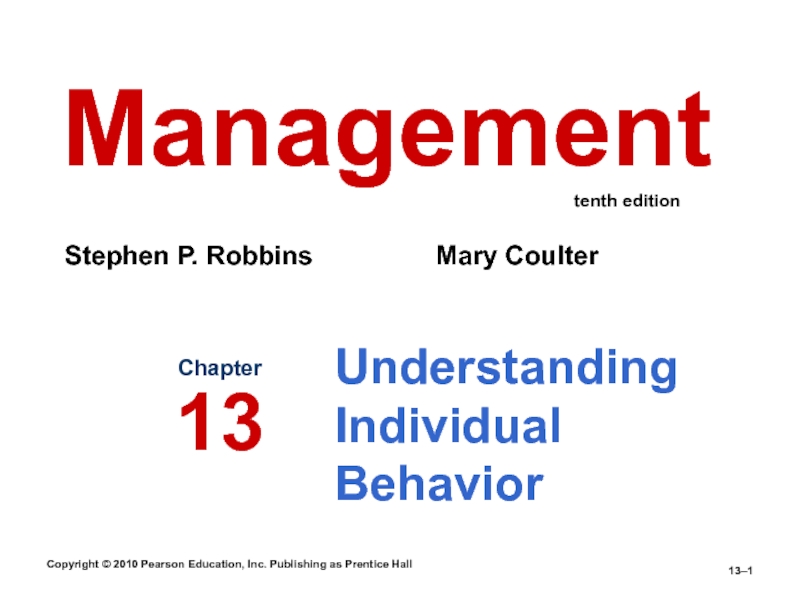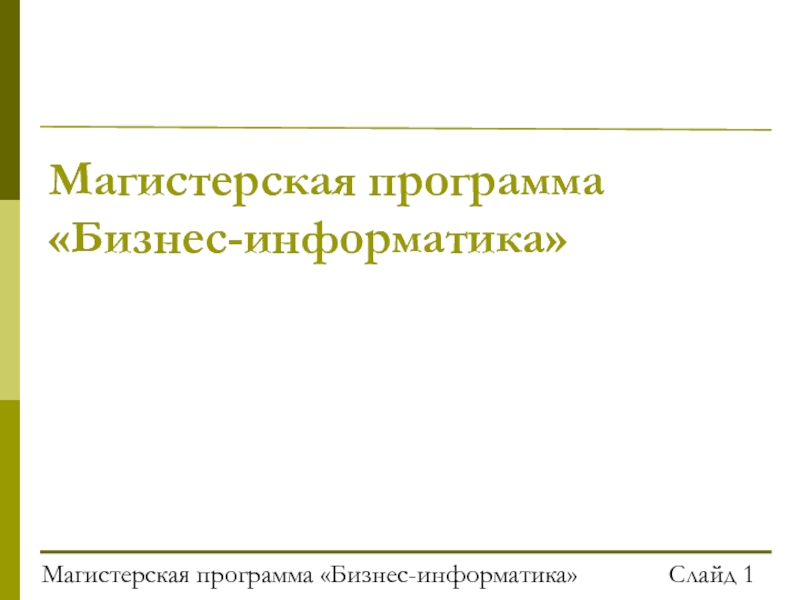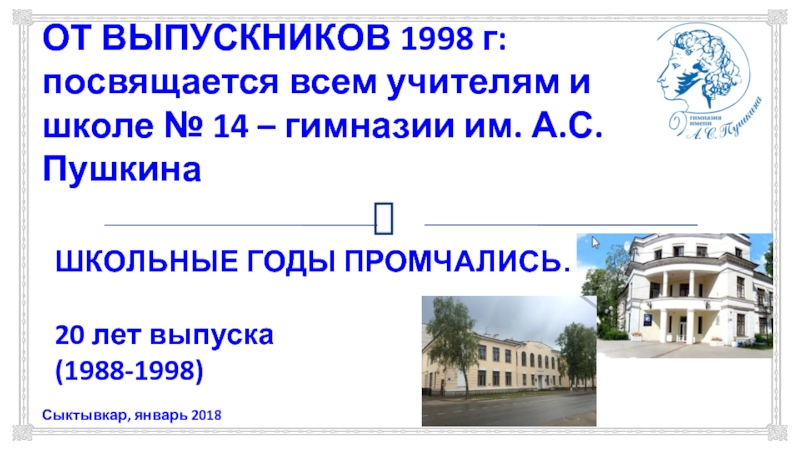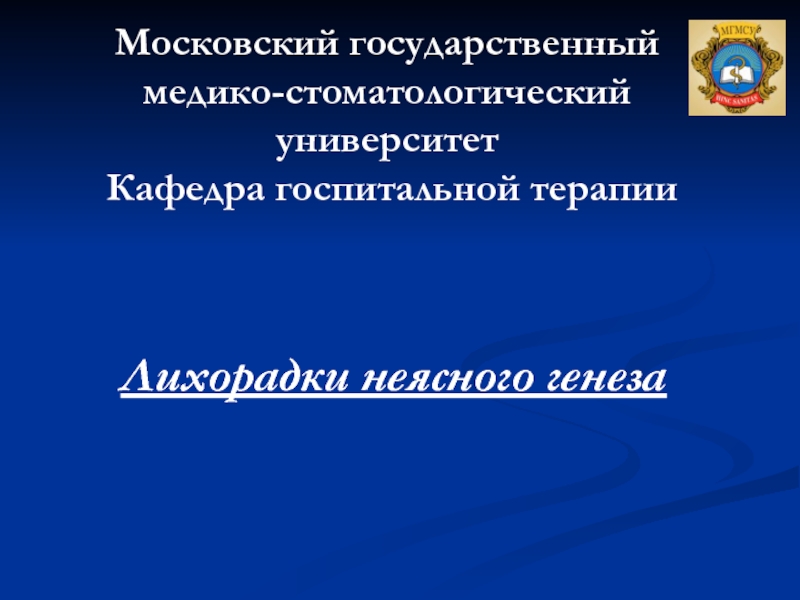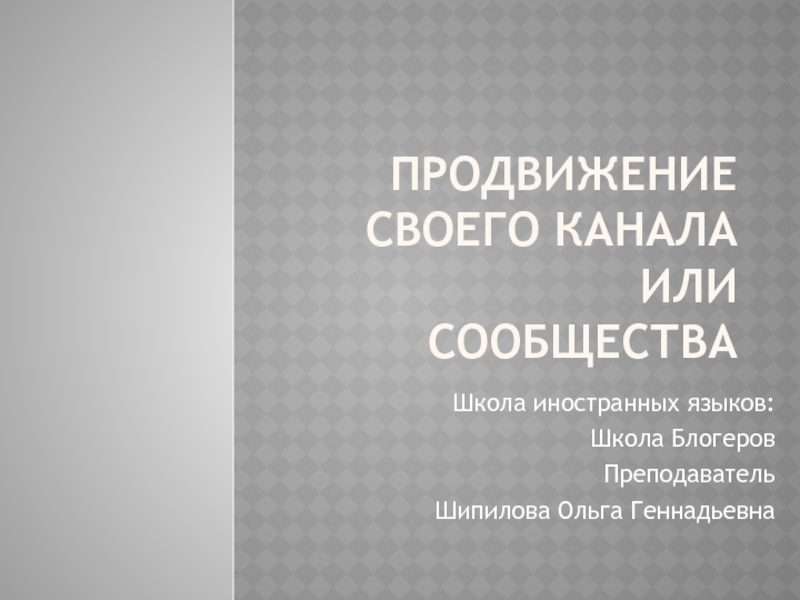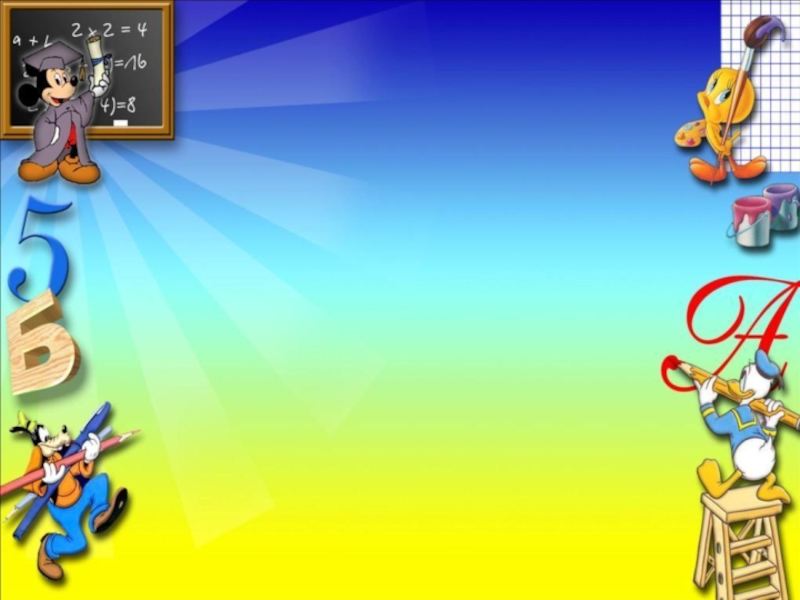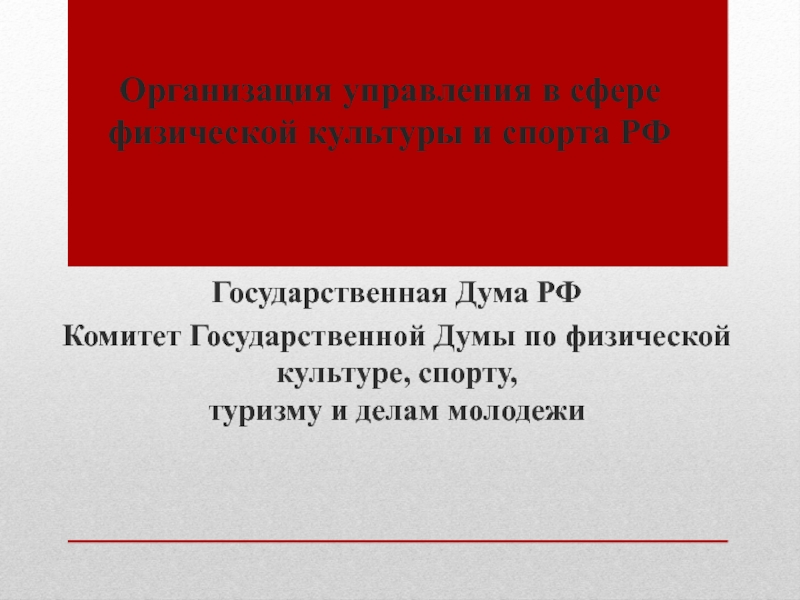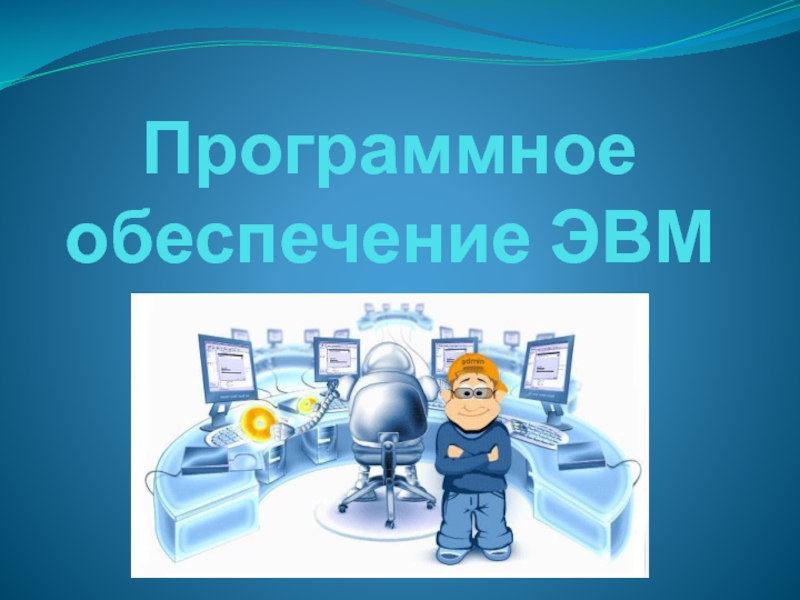Разделы презентаций
- Разное
- Английский язык
- Астрономия
- Алгебра
- Биология
- География
- Геометрия
- Детские презентации
- Информатика
- История
- Литература
- Математика
- Медицина
- Менеджмент
- Музыка
- МХК
- Немецкий язык
- ОБЖ
- Обществознание
- Окружающий мир
- Педагогика
- Русский язык
- Технология
- Физика
- Философия
- Химия
- Шаблоны, картинки для презентаций
- Экология
- Экономика
- Юриспруденция
Understanding Individual Behavior
Содержание
- 1. Understanding Individual Behavior
- 2. Copyright © 2010 Pearson Education, Inc. Publishing
- 3. Copyright © 2010 Pearson Education, Inc. Publishing
- 4. Copyright © 2010 Pearson Education, Inc. Publishing
- 5. Copyright © 2010 Pearson Education, Inc. Publishing as Prentice Hall13–Exhibit 13.1 The Organization as an Iceberg
- 6. Copyright © 2010 Pearson Education, Inc. Publishing
- 7. Copyright © 2010 Pearson Education, Inc. Publishing
- 8. Copyright © 2010 Pearson Education, Inc. Publishing
- 9. Copyright © 2010 Pearson Education, Inc. Publishing
- 10. Copyright © 2010 Pearson Education, Inc. Publishing
- 11. Copyright © 2010 Pearson Education, Inc. Publishing
- 12. Copyright © 2010 Pearson Education, Inc. Publishing
- 13. Copyright © 2010 Pearson Education, Inc. Publishing
- 14. Copyright © 2010 Pearson Education, Inc. Publishing
- 15. Copyright © 2010 Pearson Education, Inc. Publishing
- 16. Copyright © 2010 Pearson Education, Inc. Publishing
- 17. Copyright © 2010 Pearson Education, Inc. Publishing
- 18. Copyright © 2010 Pearson Education, Inc. Publishing
- 19. Copyright © 2010 Pearson Education, Inc. Publishing as Prentice Hall13–Exhibit 13–2 Key Employee Engagement Factors
- 20. Copyright © 2010 Pearson Education, Inc. Publishing
- 21. Copyright © 2010 Pearson Education, Inc. Publishing
- 22. Copyright © 2010 Pearson Education, Inc. Publishing
- 23. Copyright © 2010 Pearson Education, Inc. Publishing
- 24. Copyright © 2010 Pearson Education, Inc. Publishing
- 25. Copyright © 2010 Pearson Education, Inc. Publishing
- 26. Copyright © 2010 Pearson Education, Inc. Publishing
- 27. Copyright © 2010 Pearson Education, Inc. Publishing
- 28. Copyright © 2010 Pearson Education, Inc. Publishing
- 29. Copyright © 2010 Pearson Education, Inc. Publishing
- 30. Copyright © 2010 Pearson Education, Inc. Publishing
- 31. Copyright © 2010 Pearson Education, Inc. Publishing
- 32. Copyright © 2010 Pearson Education, Inc. Publishing
- 33. Copyright © 2010 Pearson Education, Inc. Publishing
- 34. Copyright © 2010 Pearson Education, Inc. Publishing
- 35. Copyright © 2010 Pearson Education, Inc. Publishing
- 36. Copyright © 2010 Pearson Education, Inc. Publishing
- 37. Copyright © 2010 Pearson Education, Inc. Publishing
- 38. Copyright © 2010 Pearson Education, Inc. Publishing
- 39. Copyright © 2010 Pearson Education, Inc. Publishing
- 40. Copyright © 2010 Pearson Education, Inc. Publishing
- 41. Copyright © 2010 Pearson Education, Inc. Publishing
- 42. Copyright © 2010 Pearson Education, Inc. Publishing as Prentice Hall13–Exhibit 13.7 Attribution Theory
- 43. Copyright © 2010 Pearson Education, Inc. Publishing
- 44. Copyright © 2010 Pearson Education, Inc. Publishing
- 45. Copyright © 2010 Pearson Education, Inc. Publishing
- 46. Copyright © 2010 Pearson Education, Inc. Publishing
- 47. Copyright © 2010 Pearson Education, Inc. Publishing
- 48. Copyright © 2010 Pearson Education, Inc. Publishing
- 49. Copyright © 2010 Pearson Education, Inc. Publishing
- 50. Copyright © 2010 Pearson Education, Inc. Publishing
- 51. Copyright © 2010 Pearson Education, Inc. Publishing
- 52. Copyright © 2010 Pearson Education, Inc. Publishing
- 53. Copyright © 2010 Pearson Education, Inc. Publishing
- 54. Copyright © 2010 Pearson Education, Inc. Publishing
- 55. Copyright © 2010 Pearson Education, Inc. Publishing
- 56. Copyright © 2010 Pearson Education, Inc. Publishing
- 57. Скачать презентанцию
Слайды и текст этой презентации
Слайд 1Copyright © 2010 Pearson Education, Inc. Publishing as Prentice Hall
13–
Understanding
Individual Behavior
Слайд 2Copyright © 2010 Pearson Education, Inc. Publishing as Prentice Hall
13–
Learning
Outcomes Follow this Learning Outline as you read and study this
chapter.13.1 Focus and Goals of Individual Behavior
Explain why the concept of an organization as an iceberg is important to understanding organizational behavior.
Describe the focus and the goals of organizational behavior.
Define the six important employee behaviors that managers want to explain, predict, and influence.
13.2 Attitudes and Performance
Describe the three components of an attitude.
Explain the four job-related attitudes.
Describe the impact job satisfaction has on employee behavior.
Слайд 3Copyright © 2010 Pearson Education, Inc. Publishing as Prentice Hall
13–
Learning
Outcomes
13.3 Personality
Contrast the MBTI® and the big five model of
personality.Describe the five personality traits that have proved to be most powerful in explaining individual behavior in organizations.
Explain how emotions and emotional intelligence impact behavior.
13.4 Learning
• Explain how operant conditioning helps managers.
• Describe the implications of social learning theory.
Discuss how managers can shape behavior.
Слайд 4Copyright © 2010 Pearson Education, Inc. Publishing as Prentice Hall
13–
Learning
Outcomes
13.5 Contemporary OB Issues
Describe the challenges managers face in managing
Gen Y workers.Explain what managers can do to deal with workplace misbehavior.
Слайд 5Copyright © 2010 Pearson Education, Inc. Publishing as Prentice Hall
13–
Exhibit
13.1 The Organization as an Iceberg
Слайд 6Copyright © 2010 Pearson Education, Inc. Publishing as Prentice Hall
13–
The
Focus and Goals of Individual Behavior
Organizational Behavior (OB)
The actions of
people at workFocus of Organizational Behavior
Individual behavior
Attitudes, personality, perception, learning, and motivation
Group behavior
Norms, roles, team building, leadership, and conflict
Organizational
Structure, culture, and human resource policies and practices
Слайд 7Copyright © 2010 Pearson Education, Inc. Publishing as Prentice Hall
13–
Goals
of Organizational Behavior
To explain, predict and influence behavior.
Employee Productivity
A performance
measure of both efficiency and effectivenessAbsenteeism
The failure to report to work when expected
Turnover
The voluntary and involuntary permanent withdrawal from an organization
Слайд 8Copyright © 2010 Pearson Education, Inc. Publishing as Prentice Hall
13–
Important
Employee Behaviors (cont’d)
Organizational Citizenship Behavior (OCB)
Discretionary behavior that is not
a part of an employee’s formal job requirements, but which promotes the effective functioning of the organization.Job Satisfaction
The individual’s general attitude toward his or her job
Слайд 9Copyright © 2010 Pearson Education, Inc. Publishing as Prentice Hall
13–
Important
Employee Behaviors (cont’d)
Workplace Misbehavior
Any intentional employee behavior that has negative
consequences for the organization or individuals within the organization.Types of Misbehavior
Deviance
Aggression
Antisocial behavior
Violence
Слайд 10Copyright © 2010 Pearson Education, Inc. Publishing as Prentice Hall
13–
Psychological
Factors Affecting Employee Behavior
Attitudes
Personality
Perception
Learning
Employee Productivity
Absenteeism
Turnover
Organizational Citizenship
Job Satisfaction
Workplace Misbehavior
Слайд 11Copyright © 2010 Pearson Education, Inc. Publishing as Prentice Hall
13–
Psychological
Factors – Attitudes
Attitudes
Evaluative statements—either favorable or unfavorable—concerning objects, people, or
events.Components of an Attitude
Cognitive component: the beliefs, opinions, knowledge, or information held by a person.
Affective component: the emotional or feeling part of an attitude.
Behavioral component: the intention to behave in a certain way.
Слайд 12Copyright © 2010 Pearson Education, Inc. Publishing as Prentice Hall
13–
Job
Satisfaction
Job satisfaction is affected by level of income earned and
by the type of job a worker does.Job Satisfaction and Productivity
The correlation between satisfaction and productivity is fairly strong.
Organizations with more satisfied employees are more effective than those with fewer satisfied employees.
Psychological Factors – Attitudes
Слайд 13Copyright © 2010 Pearson Education, Inc. Publishing as Prentice Hall
13–
Job
Satisfaction and Absenteeism
Satisfied employees tend to have lower levels of
absenteeism, although satisfied employees are bound to take company approved days off (e.g. sick days)Job Satisfaction and Turnover
Satisfied employees have lower levels of turnover; dissatisfied employees have higher levels of turnover.
Turnover is affected by the level of employee performance.
The preferential treatment afforded superior employees makes satisfaction less important in predicting their turnover decisions.
Psychological Factors – Attitudes
Слайд 14Copyright © 2010 Pearson Education, Inc. Publishing as Prentice Hall
13–
Job
Satisfaction and Customer Satisfaction
The level of job satisfaction for frontline
employees is related to increased customer satisfaction and loyalty.Interaction with dissatisfied customers can increase an employee’s job dissatisfaction.
Actions to increase job satisfaction for customer service workers:
Hire upbeat and friendly employees.
Reward superior customer service.
Provide a positive work climate.
Use attitude surveys to track employee satisfaction.
Psychological Factors – Attitudes
Слайд 15Copyright © 2010 Pearson Education, Inc. Publishing as Prentice Hall
13–
Job
Satisfaction and Organizational Citizenship Behavior (OCB)
Relationship between job satisfaction and
OCB is tempered by perceptions of fairnessIndividual OCB is influenced by work group OCB
Job Satisfaction and Workplace Misbehavior
Dissatisfied employees will respond somehow
Not easy to predict exactly how they’ll respond
Psychological Factors – Attitudes
Слайд 16Copyright © 2010 Pearson Education, Inc. Publishing as Prentice Hall
13–
Job
Involvement
The degree to which an employee identifies with his or
her job, actively participates in it, and considers his or her performance to be important to his or her self-worth.High levels of commitment are related to fewer absences and lower resignation rates.
Psychological Factors – Attitudes
Слайд 17Copyright © 2010 Pearson Education, Inc. Publishing as Prentice Hall
13–
Organizational
Commitment
Is the degree to which an employee identifies with a
particular organization and its goals and wishes to maintain membership in the organization.Leads to lower levels of both absenteeism and turnover.
Could be becoming an outmoded measure as the number of workers who change employers increases.
Psychological Factors – Attitudes
Слайд 18Copyright © 2010 Pearson Education, Inc. Publishing as Prentice Hall
13–
Perceived
Organizational Support
Is the general belief of employees that their organization
values their contribution and cares about their well-being.Represents the commitment of the organization to the employee.
Providing high levels of support increases job satisfaction and lower turnover.
Psychological Factors – Attitudes
Слайд 19Copyright © 2010 Pearson Education, Inc. Publishing as Prentice Hall
13–
Exhibit
13–2 Key Employee Engagement Factors
Слайд 20Copyright © 2010 Pearson Education, Inc. Publishing as Prentice Hall
13–
Attitudes
and Consistency
People seek consistency in two ways:
Consistency among their attitudes.
Consistency
between their attitudes and behaviors.If an inconsistency arises, individuals:
Alter their attitudes or
Alter their behavior or
Develop a rationalization for the inconsistency
Слайд 21Copyright © 2010 Pearson Education, Inc. Publishing as Prentice Hall
13–
Cognitive
Dissonance Theory
Cognitive Dissonance
Any incompatibility or inconsistency between attitudes or between
behavior and attitudes.Any form of inconsistency is uncomfortable and individuals will try to reduce the dissonance.
The intensity of the desire to reduce the dissonance is influenced by:
The importance of the factors creating the dissonance.
The degree to which an individual believes that the factors causing the dissonance are controllable.
Rewards available to compensate for the dissonance.
Слайд 22Copyright © 2010 Pearson Education, Inc. Publishing as Prentice Hall
13–
Attitude
Surveys
Attitude Surveys
A instrument/document that presents employees with a set of
statements or questions eliciting how they feel about their jobs, work groups, supervisors, or their organization.Provide management with feedback on employee perceptions of the organization and their jobs.
Слайд 23Copyright © 2010 Pearson Education, Inc. Publishing as Prentice Hall
13–
Exhibit
13–3 Sample Employee Survey
To measure employee attitudes, some
KFC and Long John Silver’s restaurants ask employeesto react to statements such as:
• My restaurant is a great place to work.
• People on my team help out, even if it is not their job.
• I am told whether I am doing good work or not.
• I understand the employee benefits that are available to me.
Слайд 24Copyright © 2010 Pearson Education, Inc. Publishing as Prentice Hall
13–
The
Importance of Attitudes
Implication for Managers
Attitudes warn of potential behavioral problems:
Managers should do things that generate the positive attitudes that reduce absenteeism and turnover.
Attitudes influence behaviors of employees:
Managers should focus on helping employees become more productive to increase job satisfaction.
Employees will try to reduce dissonance unless:
Managers identify the external sources of dissonance.
Managers provide rewards compensating for the dissonance.
Слайд 25Copyright © 2010 Pearson Education, Inc. Publishing as Prentice Hall
13–
Personality
The
unique combination of emotional, thought and behavioral patterns that affect
how a person reacts and interacts with others.Psychological Factors – Personality
Слайд 26Copyright © 2010 Pearson Education, Inc. Publishing as Prentice Hall
13–
Classifying
Personality Traits
Myers Briggs Type Indicator (MBTI®)
A general personality assessment tool
that measures the personality of an individual using four categories:Social interaction: Extrovert or Introvert (E or I)
Preference for gathering data: Sensing or Intuitive (S or N)
Preference for decision making: Feeling or Thinking (F or T)
Style of decision making: Perceptive or Judgmental (P or J)
Слайд 27Copyright © 2010 Pearson Education, Inc. Publishing as Prentice Hall
13–
Exhibit
13.4 Examples of MBTI® Types
Source: Based on I. Briggs-Myers, Introduction to
Type (Palo Alto, CA: Consulting Psychologists Press, 1980), pp. 7–8.Слайд 28Copyright © 2010 Pearson Education, Inc. Publishing as Prentice Hall
13–
The
Big-Five Model
Extraversion
Sociable, talkative, and assertive
Agreeableness
Good-natured, cooperative, and trusting
Conscientiousness
Responsible, dependable, persistent,
and achievement orientedEmotional Stability
Calm, enthusiastic, and secure or tense, nervous, and insecure
Openness to Experience
Imaginative, artistically sensitive, and intellectual
Слайд 29Copyright © 2010 Pearson Education, Inc. Publishing as Prentice Hall
13–
Additional
Personality Insights
Locus of Control
Internal locus: persons who believe that
they control their own destiny.External locus: persons who believe that what happens to them is due to luck or chance (the uncontrollable effects of outside forces).
Machiavellianism (Mach)
The degree to which an individual is pragmatic, maintains emotional distance, and seeks to gain and manipulate power—ends can justify means.
Слайд 30Copyright © 2010 Pearson Education, Inc. Publishing as Prentice Hall
13–
Self-Esteem
(SE)
The degree to which people like or dislike themselves
High SEs
Believe
in themselves and expect success.Take more risks and use unconventional approaches.
Are more satisfied with their jobs than low SEs.
Low SEs
Are more susceptible to external influences.
Depend on positive evaluations from others.
Are more prone to conform than high SEs.
Additional Personality Insights
Слайд 31Copyright © 2010 Pearson Education, Inc. Publishing as Prentice Hall
13–
Self-Monitoring
An
individual’s ability to adjust his or her behavior to external,
situational factors.High self-monitors:
Are sensitive to external cues and behave differently in different situations.
Can present contradictory public persona and private selves—impression management.
Low self-monitors
Do not adjust their behavior to the situation.
Are behaviorally consistent in public and private.
Additional Personality Insights
Слайд 32Copyright © 2010 Pearson Education, Inc. Publishing as Prentice Hall
13–
Risk
Taking
The propensity (or willingness) to take risks.
High risk-takers take less
time and require less information than low risk-takers when making a decision.Organizational effectiveness is maximized when the risk-taking propensity of a manager is aligned with the specific demands of the job assigned to the manager.
Additional Personality Insights
Слайд 33Copyright © 2010 Pearson Education, Inc. Publishing as Prentice Hall
13–
Personality
Types in Different Cultures
The Big Five model is used in
cross-cultural studies. Differences are found in the emphasis of dimensions.
No common personality types for a given country
A country’s culture influences the dominant personality characteristics of its people.
Global managers need to understand personality trait differences from the perspective of each culture.
Слайд 34Copyright © 2010 Pearson Education, Inc. Publishing as Prentice Hall
13–
Emotions
Emotions
Intense
feelings (reactions) that are directed at specific objects (someone or
something)Universal emotions:
Anger
Fear
Sadness
Happiness
Disgust
Surprise
Слайд 35Copyright © 2010 Pearson Education, Inc. Publishing as Prentice Hall
13–
Emotional
Intelligence
Emotional Intelligence (EI)
The ability to notice and to manage emotional
cues and information.Dimensions of EI:
Self-awareness: knowing what you’re feeling
Self-management: managing emotions and impulses
Self-motivation: persisting despite setbacks and failures
Empathy: sensing how others are feeling
Social skills: handling the emotions of others
Слайд 36Copyright © 2010 Pearson Education, Inc. Publishing as Prentice Hall
13–
Implications
for Managers
Employee selection
Holland’s Personality-Job Fit Theory
Helps in understanding employee
behavior(s)By understanding others’ behavior(s), can work better with them
Слайд 37Copyright © 2010 Pearson Education, Inc. Publishing as Prentice Hall
13–
Understanding
Personality Differences
Personality Job Fit Theory (Holland)
An employee’s job satisfaction and
likelihood of turnover depends on the compatibility of the employee’s personality and occupation.Key points of the theory:
There are differences in personalities.
There are different types of jobs.
Job satisfaction and turnover are related to the match between personality and job for an individual.
Слайд 38Copyright © 2010 Pearson Education, Inc. Publishing as Prentice Hall
13–
Exhibit
13.5 Holland’s Typology of Personality and Sample Occupations
Source: Based on J.
L. Holland, Making Vocational Choices: A Theory of Vocational Personalities and Work Environments (Odessa, FL: Psychological Assessment Resources, 1997).Слайд 39Copyright © 2010 Pearson Education, Inc. Publishing as Prentice Hall
13–
Perception
A
process by which individuals give meaning (reality) to their environment
by organizing and interpreting their sensory impressions.Factors influencing perception:
The perceiver’s personal characteristics—interests, biases and expectations
The target’s characteristics—distinctiveness, contrast, and similarity
The situation (context) factors—place, time, location—draw attention or distract from the target
Psychological Factors – Perception
Слайд 40Copyright © 2010 Pearson Education, Inc. Publishing as Prentice Hall
13–
Exhibit
13.6 Perception Challenges: What Do You
See?
Слайд 41Copyright © 2010 Pearson Education, Inc. Publishing as Prentice Hall
13–
How
We Perceive People
Attribution Theory
How the actions of individuals are perceived
by others depends on what meaning (causation) we attribute to a given behavior.Internally caused behavior: under the individual’s control
Externally caused behavior: due to outside factors
Determining the source of behaviors:
Distinctiveness: different behaviors in different situations
Consensus: behaviors similar to others in same situation
Consistency: regularity of the same behavior over time
Слайд 42Copyright © 2010 Pearson Education, Inc. Publishing as Prentice Hall
13–
Exhibit
13.7 Attribution Theory
Слайд 43Copyright © 2010 Pearson Education, Inc. Publishing as Prentice Hall
13–
How
We Perceive People (cont’d)
Attribution Theory – errors and biases (cont’d)
Fundamental
attribution errorThe tendency to underestimate the influence of external factors and to overestimate the influence of internal or personal factors.
Self-serving bias
The tendency of individuals to attribute their successes to internal factors while blaming personal failures on external factors.
Слайд 44Copyright © 2010 Pearson Education, Inc. Publishing as Prentice Hall
13–
Shortcuts
Used in Judging Others
Assumed Similarity
Assuming that others are more like
us than they actually are.Stereotyping
Judging someone on the basis of our perception of a group he or she is a part of.
Halo Effect
Forming a general impression of a person on the basis of a single characteristic of that person.
Слайд 45Copyright © 2010 Pearson Education, Inc. Publishing as Prentice Hall
13–
Implications
for Managers
Employees react to perceptions
Pay close attention to how employees
perceive their jobs and management actionsСлайд 46Copyright © 2010 Pearson Education, Inc. Publishing as Prentice Hall
13–
Learning
Any
relatively permanent change in behavior that occurs as a result
of experience.Almost all complex behavior is learned.
Learning is a continuous, life-long process.
The principles of learning can be used to shape behavior.
Theories of learning:
Operant conditioning
Social learning
Psychological Factors – Learning
Слайд 47Copyright © 2010 Pearson Education, Inc. Publishing as Prentice Hall
13–
Learning
(cont’d)
Operant Conditioning (B.F. Skinner)
The theory that behavior is a function
of its consequences and is learned through experience.Operant behavior: voluntary or learned behaviors
Behaviors are learned by making rewards contingent to behaviors.
Behavior that is rewarded (positively reinforced) is likely to be repeated.
Behavior that is punished or ignored is less likely to be repeated.
Слайд 48Copyright © 2010 Pearson Education, Inc. Publishing as Prentice Hall
13–
Learning
(cont’d)
Social Learning
The theory that individuals learn through their observations of
others and through their direct experiences.Attributes of models that influence learning:
Attentional: the attractiveness or similarity of the model
Retention: how well the model can be recalled
Motor reproduction: the reproducibility of the model’s actions
Reinforcement: the rewards associated with learning the model behavior
Слайд 49Copyright © 2010 Pearson Education, Inc. Publishing as Prentice Hall
13–
Shaping:
A Managerial Tool
Shaping Behavior
Attempting to “mold” individuals by guiding their
learning in graduated steps such that they learn to behave in ways that most benefit the organization.Shaping methods:
Positive reinforcement: rewarding desired behaviors.
Negative reinforcement: removing an unpleasant consequence once the desired behavior is exhibited.
Punishment: penalizing an undesired behavior.
Extinction: eliminating a reinforcement for an undesired behavior.
Слайд 50Copyright © 2010 Pearson Education, Inc. Publishing as Prentice Hall
13–
Implications
for Managers
If managers want behavior A but reward behavior B,
employees will engage in behavior B.Employees will look to managers as models. Good manager behavior will promote good employee behavior.
Слайд 51Copyright © 2010 Pearson Education, Inc. Publishing as Prentice Hall
13–
Contemporary
Issues in OB
Managing Generational Differences in the Workplace
Gen Y: individuals
born after 1978Bring new attitudes to the workplace that reflect wide arrays of experiences and opportunities
Want to work, but don’t want work to be their life
Challenge the status quo
Have grown up with technology
Слайд 52Copyright © 2010 Pearson Education, Inc. Publishing as Prentice Hall
13–
Exhibit
13.8 Gen Y Workers
Source: Bruce Tulgan of Rainmaker Thinking. Used with
permission.Слайд 53Copyright © 2010 Pearson Education, Inc. Publishing as Prentice Hall
13–
Contemporary
Issues in OB
Managing Negative Behavior in the Workplace
Tolerating negative behavior
sends the wrong message to other employeesBoth preventive and responsive actions to negative behaviors are needed:
Screening potential employees
Responding immediately and decisively to unacceptable behavior
Paying attention to employee attitudes
Слайд 54Copyright © 2010 Pearson Education, Inc. Publishing as Prentice Hall
13–
Terms
to Know
behavior
organizational behavior
employee productivity
absenteeism
turnover
organizational citizenship behavior
job satisfaction
workplace misbehavior
attitudes
cognitive component
affective component
behavioral
componentjob involvement
organizational commitment
perceived organizational support
cognitive dissonance
attitude surveys
personality
Big Five Model
locus of control
Machiavellianism
Слайд 55Copyright © 2010 Pearson Education, Inc. Publishing as Prentice Hall
13–
Terms
to Know (cont’d)
self-esteem
self-monitoring
impression management
emotions
emotional intelligence (EI)
perception
attribution theory
fundamental attribution error
self-serving bias
assumed
similaritystereotyping
halo effect
learning
operant conditioning
social learning theory
shaping behavior
